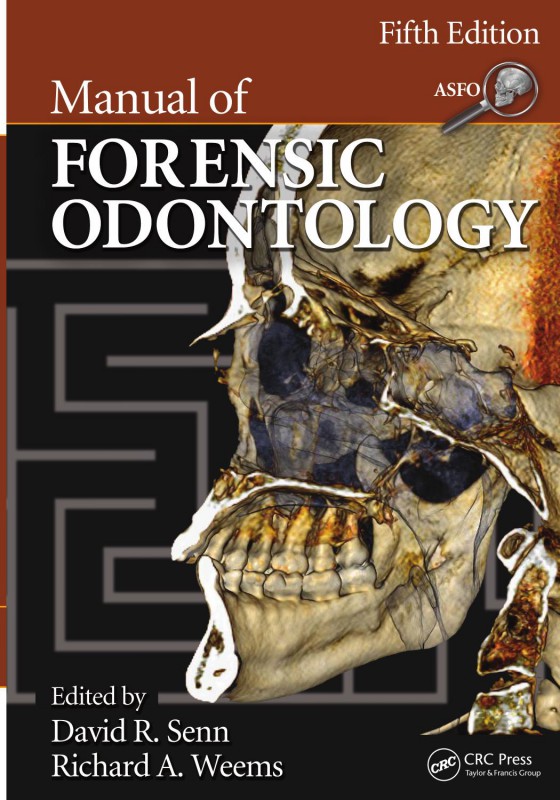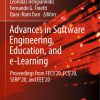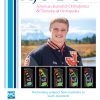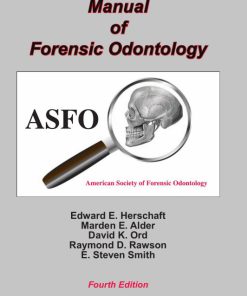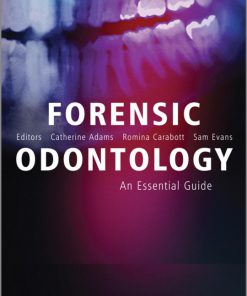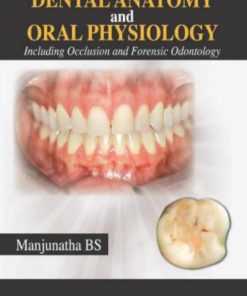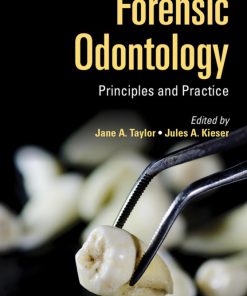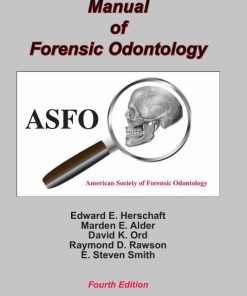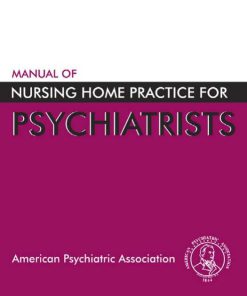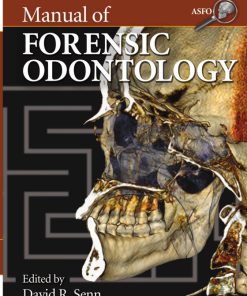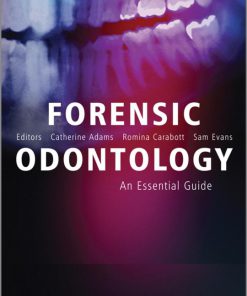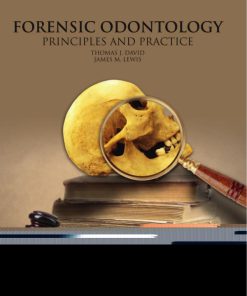Manual of Forensic Odontology 5th Edition by David Greene,David Williams 9781040081389 104008138X
$50.00 Original price was: $50.00.$25.00Current price is: $25.00.
Authors:Senn, David R.; Editor; Weems, Richard A.; Editor , Author sort:Senn, David R.; Editor; Weems, Richard A.; Editor , Published:Published:Dec 2012
Manual of Forensic Odontology 5th Edition by David Greene,David Williams – Ebook PDF Instant Download/Delivery.9781040081389, 104008138X
Full download Manual of Forensic Odontology 5th Edition after payment
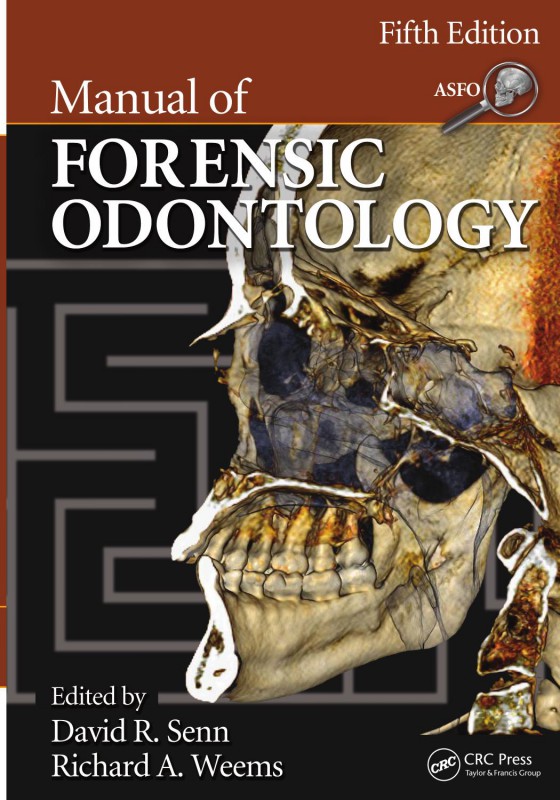
Product details:
ISBN 10: 104008138X
ISBN 13:9781040081389
Author:David Greene,David Williams
Advances in forensic odontology have led to improvements in dental identification for individual cases as well as in disaster victim identification (DVI). New and updated technologies mean advances in bitemark analysis and age estimation. Growth in the field has strengthened missing persons networks leading to more and faster identifications
Manual of Forensic Odontology 5th Table of contents:
1 History of Forensic Odontology
1.1 Coroner and Medical Examiner Systems
1.1.1 Significant Dates in the Evolution of U.S. Coronerand Medical Examiner Systems
1.1.2 Distribution of Medical Examiners and Coroners by State
1.2 Dental Identification
1.2.1 Agrippina the Younger Identifies Lollia Paulina, AD 49
1.2.2 Pliny the Elder Publishes Natural History, AD 77
1.2.3 First Earl of Shrewsbury Identified by His Herald, 1453
1.2.4 Charles the Bold Identified by His Page, 1477
1.2.5 Colonel Sir Peter Halket(t), 1758
1.2.6 Dr. Joseph Warren Identified by Paul Revere, 1776
1.2.7 First British Trial in Which Dentists Were Cited as Expert Witnesses, 1814
1.2.8 Caroline Walsh, 1831
1.2.9 Homicide at Harvard: Dr. George Parkman and Dr. John Webster, 1849
1.2.10 John Wilkes Booth, 1865 and 1869
1.2.11 Second Lieutenant Henry M. Harrington, 1885
1.2.12 Claudius Beaupied, Victim of the “Killer of the Little Shepherds,” 1897
1.2.13 Adolf Hitler, 1945
1.2.14 Henrietta Durand-Deacon, Final Victim of the “Acid Bath Murderer,” 1949
1.2.15 Exhumation of Lee Harvey Oswald, 1981
1.2.16 Czar Nicholas II, the Last Czar of Russia, 1991 and 2008
1.2.17 Ramses I, 2003
1.2.18 Queen Hatshepsut, 2007
1.3 Disaster Victim Identification
1.3.1 Bazar de la Charite, 1897
1.3.2 Disaster Relief Act of 1974 (Public Law 93-288)
1.3.3 Jonestown, 1978
1.3.4 John Wayne Gacy, 1978
1.3.5 American Airlines Flight 191, 1979
1.3.6 Disaster Mortuary Operational Response Team (DMORT), 1992
1.3.7 Waco Siege, 1993
1.3.8 Oklahoma City Bombing, 1995
1.3.9 World Trade Center, New York; The Pentagon, Virginia, and Shanksville, Pennsylvania, 2001
1.3.10 Hurricane Katrina, 2005
1.3.11 Haiti Earthquake, 2010
1.4 Bitemarks and Bitemark Cases
1.4.1 William I of England, 1027–1087
1.4.2 George Burroughs and the Salem Witch Trials, 1692
1.4.3 Ansil L. Robinson Murder Trial, 1870
1.4.4 Doyle v. Texas, 1954
1.4.5 Public Prosecutor (Norway) v. Torgersen, 1958
1.4.6 Crown (Scotland) v. Hay, 1967
1.4.7 Illinois v. Johnson, 1972
1.4.8 California v. Marx, 1975
1.4.9 Illinois v. Milone, 1976
1.4.10 Florida v. Bundy, 1979
1.4.11 Florida v. Stewart, 1979
1.4.12 State of Wisconsin v. Robert Lee Stinson, 1984
1.4.13 Louisiana v. Willie Jackson, 1986
1.4.14 Oklahoma v. Wilhoit, 1987
1.4.15 Commonwealth of Pennsylvania v. Kunco, 1991
1.4.16 New York v. Roy Brown, 1992
1.4.17 Arizona v. Krone, 1992 and 1996
1.4.18 Michigan v. Moldowan and Cristini, 1991
1.4.19 Illinois v. Young and Hill, 1992
1.4.20 Mississippi v. Brewer, 1995, and Mississippi v. Brooks, 1992
1.4.21 West Memphis Three, 1994, Alford Plea 2011
1.4.22 New Jersey v. Jesse K. Timmendequas, 1997: Megan’s Law
1.4.23 Massachusetts v. Edmund Burke, 1998
1.4.24 State of New York v. James O’Donnell, 1998
1.5 Age Estimation
1.5.1 Louis XVII “The Lost Dauphin,” 1894
1.5.2 Massler and Shour, 1941 and 1944
1.5.3 Moorrees, Fanning and Hunt, 1963
1.5.4 Mincer, Harris, and Berryman, 1993
1.5.5 King Tutankhamen, 2005
1.6 Abuse and Neglect
1.6.1 Mary Ellen Wilson, 1874
1.7 Forensic Odontology; Books and Chapters in Books
Acknowledgments
References
2 Forensic Pathology
2.1 Forensic Pathology Defined
2.2 Death Investigation
2.2.1 History
2.2.2 Scene Investigation
2.2.3 Evidence Collection
2.3 Changes after Death
2.3.1 Rigor Mortis
2.3.2 Livor Mortis (Hypostasis)
2.3.3 Algor Mortis (Postmortem Cooling)
2.3.4 Tissue Decomposition
2.3.5 Stomach Contents
2.4 Time of Death
2.5 Cause of Death
2.5.1 Natural Deaths
2.5.2 Blunt Force Trauma
2.5.3 Sharp Force Trauma
2.5.4 Gunshot Wounds
2.5.5 Asphyxia
2.5.6 Fire
2.5.7 Drugs
2.6 Manner of Death
2.7 Autopsy Reports
2.8 Death Certificates
2.9 Professional Relationships
References
3 Science and Forensic Odontology
3.1 Definition of Science
3.1.1 Perspective on Science
3.1.2 Scientific Method
3.2 Experimental Design and Terms of Methodology
3.2.1 Bias
3.2.2 Error
3.2.3 Standard Deviation and Variance
3.2.4 Other Considerations with Regard to Error: Accuracy versus Precision
3.2.5 P Value
3.2.6 Correlation/Nonuniformity
3.3 Types of Clinical Studies: Randomized Control Trials
3.3.1 Single Blind Study
3.3.2 Double-Blind Study
3.4 Validity: Sensitivity and Specificity
3.4.1 Sensitivity
3.4.2 Specificity
3.5 Science in the Courtroom
3.6 Landmark Cases for Admissibility of Scientific Evidence in the Courtroom
3.6.1 Frye Test
3.6.2 Daubert Standard
3.7 Qualifications of an Expert Witness with Regard to Scientific Basis
3.7.1 Specialty Certification
3.8 How Science Is Viewed in the Courtroom—CSIEffect: Expectations of a Jury
3.9 Challenges to and Support of Forensic Odontology Science
3.9.1 Challenges
3.9.2 2009 National Research Council Report on Forensic Sciences
3.9.3 Research Funding Sources
3.9.3.1 American Board of Forensic Odontology
3.9.3.2 American Society of Forensic Odontology
3.9.3.3 ASFO, Dr. Gerald Reynolds Research Grant for New Investigators Dr. Reynolds was a strong proponent for employing the scientific method in testing new theories in forensic odontology and initiated this grant to encourage members of the ASFO to conduct peer-reviewed research. The $500 grant is available to ASFO members for their first research project in the field of forensic dentistry. For more information, refer to the ASFO’s website: www.asfo.org.
3.9.3.4 Forensic Science Foundation: Acorn Grants
3.9.3.5 Forensic Science Foundation: Lucas Grants
3.9.3.6 Forensic Science Foundation: Jan Grant Award
3.9.3.7 NIJ/FSF Forensic Science Student Research Grant
3.9.3.8 Grants.gov
3.9.3.9 National Institute of Justice
3.9.3.10 Midwest Forensic Resource Center
3.10 Needed Research
3.10.1 Bitemark and Patterned Injury Research
3.10.2 Identification Research
3.10.3 Mass Fatality Incident Management Research
3.10.4 Victim Abuse Research
3.10.5 Witness Consultation and Testimony Research
3.10.6 Age Estimation
3.10.7 Facial Approximation Research
References
4 Dental Identification
4.1 Human Identification
4.1.1 Methods of Human Identification
4.1.1.1 Visual
4.1.1.2 Fingerprints
4.1.1.3 Anthropology/Radiology
4.1.1.4 DNA
4.1.1.5 Dental
4.1.2 Postmortem Dental Profiling
4.1.3 Burned and Incinerated Remains
4.1.4 Cremated Remains
4.2 Tooth Numbering Systems (Dental Notation, Dental Nomenclature)
4.2.1 Introduction
4.2.2 Various Systems
4.2.2.1 Universal Numbering System
4.2.2.2 FDI (Federation Dentaire Internationale)
4.2.2.3 Palmer Notation System
4.3 Dental and Nondental Comparison
4.3.1 Photographic Facial Superimposition
4.3.2 Facial Reconstruction
4.3.3 Frontal Sinus Pattern Radiographic Comparisons
4.3.4 DNA
4.3.5 Rugae
4.3.6 Cheiloscopy
4.3.7 Dental Appliances
4.3.7.1 Denture Labeling Law
4.3.7.2 Denture Teeth Molds, Size, Shape, Color
4.3.7.3 Orthodontic Fixed Appliances
4.3.8 Dental Implants
4.4 Postmortem Dental Data
4.4.1 Collection of Postmortem Data
4.4.1.1 Postmortem Dental Charting Forms
4.4.1.2 Examination Procedures
4.4.1.3 Photography
4.4.1.4 Radiography
4.4.1.5 Viewable Remains
4.4.1.6 Nonviewable Remains
4.4.1.7 Dental Examination
4.5 Antemortem Dental Data
4.5.1 Presumptive Identification
4.5.2 Locating Antemortem Dental Records
4.5.2.1 Nontraditional Sources of Antemortem Dental Information
4.5.3 What Antemortem Dental Records Should Be Requested
4.5.4 Release of Dental Records and Chain of Custody
4.5.5 Antemortem Record Form
4.6 Comparison
4.6.1 Dental Features for Comparison
4.6.2 Statistical and Mathematic/Algorithm Methods
4.6.3 Dental Identification Guidelines
4.6.4 Report Writing
4.7 Advanced Methods of Dental Materials Evidence Analysis
4.7.1 Challenges to and Limitations of Traditional Methods
4.7.1.1 Radiopacity
4.7.2 Methods of Detection and Analysis
4.7.2.1 Visible Light Fluorescence
4.7.2.2 Scanning Electron Microscopy/Energy-Dispersive X-Ray Spectroscopy
4.7.2.3 X-Ray Fluorescence
References
5 Dental, Oral, and Maxillofacial Radiographic Features of Forensic Interest
5.1 Introduction
5.1.1 Purpose and Scope
5.2 Radiographic Techniques Used in Forensic Identification
5.2.1 Dental Radiographs
5.2.2 Medical Imaging
5.3 Classification of Radiographic Features Used in Forensic Identification
5.3.1 Dental Structures: Abnormalities
5.3.1.1 Coronal, Pulpal, and Root Anomalies
5.3.1.2 Variations in Tooth Size
5.3.1.3 Variations in Tooth Number
5.3.1.4 Variations in Tooth Location and Orientation
5.3.2 Osseous Structures: Anatomical
5.3.3 Osseous Structures: Abnormalities
5.3.3.1 Radiolucent
5.3.3.2 Mixed Radiolucent or Radiopaque
5.3.3.3 Radiopaque
5.3.3.4 Other Radiographic Anomalies
5.4 Discussion
5.5 Conclusions
References
6 Disaster Victim Identification
6.1 Definitions and Types of Disasters
6.2 National and International Agencies and Teams
6.3 Disaster Sites and Site Management Issues
6.3.1 Notification and Assessment by Medical Examiners and Coroners
6.3.2 Temporary Morgue Location
6.3.3 Search and Recovery
6.3.4 Security and Safety
6.4 Establishing a DVI Morgue Operation (DMORT Model)
6.4.1 Components of Mortuary Operations
6.4.1.1 Decontamination
6.4.1.2 Reception/Registration
6.4.1.3 Fingerprint
6.4.1.4 Radiography
6.4.1.5 Pathology/Autopsy
6.4.1.6 Anthropology
6.4.1.7 Dental
6.4.1.8 DNA
6.4.1.9 Embalming/Casketing
6.4.1.10 Body Storage
6.4.1.11 Clerical or Information Resource Center
6.5 Protocol for a Local or State DVI Dental Section
6.5.1 Formation of a Dental Identification Team
6.5.2 Dental Section Team Leader
6.5.3 Postmortem Dental Section
6.5.4 Antemortem Dental Section
6.5.5 Dental Comparison Section
6.5.6 Dental Examination Supplies
6.5.7 Morgue Shifts
6.6 Portable Dental X-Ray Generator
6.7 Digital Dental Radiography Sensors
6.8 Computer-Assisted Dental Identification Software
6.8.1 CAPMI
6.8.2 WinID3
6.8.3 DVI System International
6.8.4 UVIS/UDIM
6.9 Technological Advances in Dental Identification/Flight 3407
References
7 Missing and Unidentified Persons
7.1 Introduction
7.2 National Crime Information Center/National Dental Image/Information Repository
7.2.1 National Crime Information Center Background
7.2.2 National Dental Image/Information Repository
7.2.3 Dental Coding Workshops
7.3 Laws Covering the Handing of Missing and Unidentified Persons
7.3.1 H.R. 1300: Billy’s Law
7.3.2 Jennifer’s Law
7.3.3 Kristen’s Law (Public Law #106–468)
7.4 Other Resources Trainings and Government Agencies
7.4.1 NCIC/NDIR Sponsored Training Sessions
7.4.2 National Missing and Unidentified Persons System (NamUs)
7.4.2.1 History of NamUs
7.4.2.2 Missing and Unidentified Persons Database
7.4.2.3 NamUs Training
7.4.3 The National Center of Missing and Exploited Children
7.4.4 Violent Criminal Apprehension Program
7.4.5 Private Sector and State Agencies
7.4.5.1 The DOE Network
7.4.5.2 Let’s Bring Them Home/National Center for Missing Adults
7.4.5.3 Florida Unidentified Decedents Database
7.4.5.4 California Missing Persons
7.4.6 Social Media
7.4.7 International Agencies
7.4.7.1 International Criminal Police Organization
7.4.7.2 Canadian Police Information Centre
7.5 Dental Information in Missing and Unidentified Cases
7.6 Conclusion
Acknowledgments
Disclaimer
References
8 Dental Age Estimation
8.1 Introduction
8.1.1 Purpose and Value
8.1.2 Scientific Rationale
8.1.3 Statistical Basis for Dental Age Estimation
8.1.4 Age Estimation Tools
8.2 Formation and Growth Techniques
8.2.1 Fetal Dental Age Estimation
8.2.2 Child Dental Age Estimation
8.2.3 Adolescent Age Estimation
8.3 Postformation Techniques
8.3.1 Historical Review
8.3.2 Adult Dental Age Estimation Techniques
8.3.2.1 Johanson Sectioning (1971)
8.3.2.2 Maples (1978)
8.3.2.3 Lamendin et al. (1992)
8.3.2.4 Prince and Ubelaker (2002)
8.3.2.5 Bang and Ramm (1970)
8.3.2.6 Kvaal et al. (1995)
8.4 Biochemical Techniques
8.4.1 Amino Acid Racemization
8.4.2 Radioactive 14C
8.5 Dental Age Estimation Guidelines and Standards
8.6 Summary
References
9 Bitemarks
9.1 Introduction
9.2 History
9.3 State of the Science
9.3.1 Recognition of Bitemarks
9.3.2 ABFO Bitemark Terminology
9.3.3 General Considerations and Need for Bitemark Analysis
9.3.4 Scientific Basis for Bitemark Analysis and Legal Testimony
9.4 Bitemark Analysis/Bitemark Comparisons
9.4.1 Bitemark Analysis Guidelines
9.4.1.1 Bitemarks
9.4.1.2 Biters
9.5 Limitations of and Appropriate Use of Bitemark Analysis
9.6 Bitemark Pattern Recognition and Collection from Humans and Inanimate Objects: Noninvasive Analysis
9.6.1 Written Request
9.6.2 Salivary Trace Evidence
9.7 Photographic Documentation of Bitemarks
9.7.1 Basic Equipment: Digital Cameras
9.7.2 Lenses
9.7.3 Flash Accessories
9.7.4 Other Desirable Accessories
9.8 Standard Photographic Views
9.8.1 Orientation Photos
9.8.2 Close-Up Working Photographs
9.9 Image Management and Storage
9.9.1 File Acquisition and File Types
9.9.2 Digital Image Storage
9.9.3 Image Enhancement
9.9.4 Plug-Ins
9.10 Three-Dimensional Evidence
9.10.1 Three-Dimensional Evidence Modeling
9.10.2 Stereolithography in Forensic Dentistry
9.11 Bitemark Impressions
9.11.1 Injury Impression Technique
9.11.2 Study Casts
9.12 Invasive Analysis
9.12.1 Tissue Incision, Excision, and Preservation
9.12.2 Transillumination
9.13 Data Collection from Suspected Biter(s)
9.14 Advanced Photographic Techniques
9.14.1 Electromagnetic Spectrum and Photography
9.14.2 Alternate Light Imaging (Fluorescent Photography)
9.14.2.1 Alternate Light Imaging Protocol
9.14.3 Reflective UVA Ultraviolet Photography
9.14.4 Infrared Photography
9.15 Analysis and Comparison of the Evidence
9.15.1 Description of the Injury
9.15.2 Description of the Dentition
9.15.3 Size Relationship Analysis
9.16 Comparison Techniques
9.16.1 Incisal Plane
9.16.2 Direct Comparison
9.16.3 Indirect Comparison
9.16.3.1 Overlay
9.16.3.2 Metric Analysis
9.16.3.3 Digital Analysis
9.16.3.4 Microscopy, Computerized Axial Tomography, and 3-D Scanning
9.16.3.5 Comparison Techniques and Conclusions
9.17 Case Opinion
Addendum: ABFO Guidelines and Standards*
ABFO Guidelines for Investigative and Final Bitemark Reports
Introduction
Inventory of Evidence Received
Inventory of Evidence Collected
Opinion Regarding the Nature of the Patterned Injury or Injuries
Methods of Analysis
Results of Analyses
Opinion
Disclaimer
ABFO Bitemark Analysis Guidelines
Description of Bitemark
Methods of Comparing Exemplars to Bitemarks*
ABFO Bitemark Terminology Guidelines
Component Injuries Seen in Bitemarks
A Characteristic
Bitemark Definitions
Describing the Bitemark
Variations
Terms Indicating Degree Of Confidence That an Injury Is a Bitemark
Descriptions and Terms Used to Relate a Suspected Biter to a Bitemark*
ABFO Standards for “Bitemark Terminology”
ABFO Bitemark Case Review Policy
References
10 Animal Bitemarks
10.1 Introduction
10.2 Insects
10.3 Aquatic Animals (Sharks, Crabs, Shrimp, Fish, Crawfish, Turtles)
10.3.1 Sharks
10.4 Reptiles (Alligators, Snakes)
10.4.1 Alligators
10.4.2 Snakes
10.5 Mammals
10.5.1 Carnivores
10.6 Canine Bite Data
10.6.1 Dog Bite Statistics
10.6.2 Dog Bite and Bitemark Liability
10.6.3 Dog Bite Injuries
10.6.4 Dog Bitemark Hierarchy
10.6.5 Dog Bite-Related Fatalities
10.7 Comparative Dental Anatomy
10.7.1 Canine Dentitions (Dogs)
10.7.2 Feline Dentition (Cats)
10.7.3 Ursine Dentitions (Bears)
10.7.4 Rodent Dentition (Rats)
10.8 Data Collection in Animal Bitemark Cases
10.9 Comparison Techniques
10.10 Abuse
10.11 Case Examples
10.11.1 Case Example: Human or Animal Attack?
10.11.2 Case Example: Guilty or Not?
10.11.3 Case Example: Egregious Mistakes
10.11.4 Case Example: High-Profile Dog Fighting Case
10.11.5 Other Case Examples
10.12 Summary
10.13 Lessons Learned and Recommendations for Animal Casework
Acknowledgments
References
11 Abuse and Violence
11.1 Introduction
11.1.1 Overview
11.1.2 Early Dental Literature
11.1.3 Dental Team’s Role
11.2 Child Abuse
11.2.1 Physical Abuse
11.2.2 Exploitation
11.2.3 Sexual Abuse
11.2.4 Emotional Abuse
11.2.5 Neglect or Deprivation
11.2.6 Munchausen Syndrome by Proxy
11.2.7 Risk Factors for Child Abuse
11.2.8 Conditions and Practices That Mimic Abuse
11.2.9 Who Are the Abusers
11.2.10 What to Look For
11.2.11 Prevention of Child Abuse
11.2.11.1 Child Abuse Prevention Councils
11.2.11.2 Child Death Review Teams
11.3 Intimate Partner Violence
11.3.1 IPV Types
11.3.2 Dental Team Awareness and Action Plan
11.3.3 RADAR (A Domestic Violence Intervention Program)
11.4 Mistreatment of the Elderly
11.4.1 Incidence and Indicators of Elderly Abuse
11.4.2 Categories of Elder Abuse
11.4.3 Reasons for Underreporting
11.4.4 Signs Mistaken for Abuse
11.4.5 Signs of Malnutrition
11.4.6 Follow-Up Care
11.5 Abuse of the Disabled
11.6 Abuse of Pregnant Women and Prenatal Abuse
11.7 Conclusion
11.8 Resources
References
12 Jurisprudence and Expert Witness Testimony
12.1 The U.S. Legal System
12.1.1 History and Terminology
12.1.2 Court Systems
12.1.3 Application of Law in Cases
12.2 Criminal Law
12.3 Civil Law
12.4 Adversarial System of Law
12.5 The Dentist as a Witness
12.5.1 Fact Witness
12.5.2 Expert Witness
12.6 Legal Terminology
12.6.1 Subpoena
12.6.2 Expert Witness Qualification and Voir Dire
12.7 Expert Witness Testimony
12.7.1 Expert Witness Immunity and Liability
12.7.2 Expert Witness Liability
12.8 Rules of Evidence
12.9 Tips for Expert Witnesses
12.9.1 Cross-Examination
12.9.2 Expert Witness Relationship with Case Counsel
References
13 Organized Forensic Dentistry
13.1 Introduction
13.2 American Organizations
13.2.1 American Society of Forensic Odontology
13.2.2 American Academy of Forensic Sciences
13.2.3 American Board of Forensic Odontology
13.3 International Organizations
13.3.1 International Association for Identification
13.3.2 International Organization for Forensic Odonto-Stomatology
13.3.3 British Association for Forensic Odontology
13.3.4 British Association for Human Identification
13.3.5 Australian Society of Forensic Odontology
13.4 Courses in Forensic Dentistry
13.4.1 Southwest Symposium on Forensic Dentistry
13.4.2 Annual Forensic Dental Identification and Emerging Technologies
13.4.3 Forensic Dentistry Program, McGill University
13.4.4 Fellowship in Forensic Odontology, UTSHCSA
13.4.5 Forensic Odontology in a Medical Examiner’s Office
13.4.6 Forensic Science, Tufts University
13.4.7 American Board of Forensic Odontology Workshops
14 Becoming Involved in Forensic Odontology
14.1 Introduction
14.2 Forensic Dentistry Organizations
14.2.1 American Society of Forensic Odontology
14.2.2 International Organization of Forensic Odonto-Stomatology
14.2.3 American Academy of Forensic Sciences—Odontology Section
14.2.3.1 Website
14.2.3.2 Annual Meeting
14.2.3.3 Journal of Forensic Sciences
14.2.4 American Board of Forensic Odontology
14.2.4.1 Website Resources Available to Nonmembers
14.2.4.2 Website Resources Available Only to Diplomates
14.2.5 International Association of Identification
14.2.5.1 Website
14.2.6 American College of Forensic Examiners International
14.3 Courses on Forensic Dentistry
14.4 Establishing a Relationship with Medico/Legal Agencies
14.4.1 Medical Examiners and Coroners
14.4.2 Dental Identification Teams
14.4.2.1 Disaster Mortuary Operational Response Team (DMORT)
14.4.2.2 Kenyon International
14.4.2.3 County and State Dental Identification Teams
14.4.3 Domestic Violence (Child/Partner/Adult) Agencies
14.4.4 Legal Professionals
14.4.5 Law Enforcement
14.4.5.1 NCIC Missing Persons Database
14.4.5.2 National Dental Image Repository
14.4.5.3 NamUs
14.4.6 Insurance Companies
14.5 Curriculum Vitae
14.6 Present Lectures on Forensic Dentistry
14.7 Closing Remarks on How to Get Involved with Forensic Dentistry
14.8 Recommended Forensic Odontology Equipment Lists
14.8.1 Dental Identification and Bite Marks
14.8.2 Dental Identification
14.8.3 Bite Mark Evidence Collection
People also search for Manual of Forensic Odontology 5th:
role of dentist in forensic odontology
manual of forensic odontology fifth edition
example of forensic odontology
what is odontology in forensics
a forensic odontologist examines the teeth of a skull
You may also like…
eBook PDF
Manual of Forensic Odontology 5th Edition by David Greene,David Williams 9781040081389 104008138X

